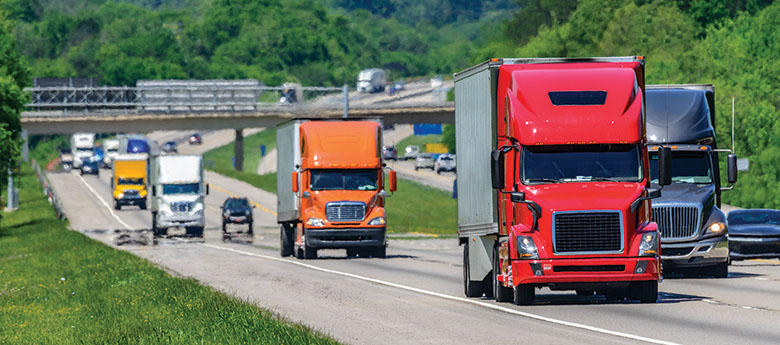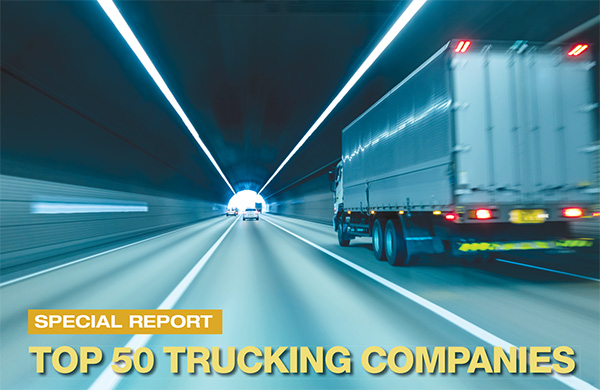2019 Top 50 Trucking Companies: Working to Stay on Top
The nation’s top carriers are making every effort to extend the trucking rally, satisfy customer needs and differentiate themselves in a cutthroat market.
By all measures, the nation’s top truckload (TL) and less-than-truckload (LTL) carriers should be able to squeeze one more solid year out of the nation’s longest economic expansion - and shippers certainly will notice because they’re the ones paying for it.
Satish Jindel, principal of SJ Consulting, is among those trucking analysts predicting that this year’s round of contractual rate negotiations will average between 4% and 8%.
“I expect 2019 to be a good year with mid- to high-single-digit rate increases for both truckload and less-than-truckload,” he says.
However, there’s growing evidence that this may be the last year of boom times for carriers.
The American Trucking Associations’ (ATA) advanced seasonally adjusted For-Hire Truck Tonnage Index increased 6.6% last year - the largest annual gain since 1998 (10.1%) and significantly better than the 3.8% increase in 2017.
But that annual gain was realized despite a decrease of 4.3% last December as the economy pumped the breaks a bit.
Bob Costello, the chief economist for the ATA, called 2018 “a banner year for truck tonnage, marking the largest annual increase we’ve seen in two decades.”
Truck tonnage closed out 2018 on a 20 year high with an annual increase of 6.6%.
However, he added that there’s evidence that in 2019 the industry and economy will moderate somewhat. Keep in mind that tonnage increased by 2.3% in January after falling 1% in December.
Nevertheless, Logistics Management’s exclusive Top 50 list is hardly static.
Truckload giant J.B. Hunt recently bought a rival to get into the e-commerce last-mile space, while scrappy northeast LTL player A. Duie Pyle moved swiftly to gain market share after the February bankruptcy of rival New England Motor Freight (NEMF).
NEMF’s demise proved that the high costs of real estate, labor, and equipment can doom even well-managed carriers that are making significant expenditures in technology, drivers, and terminals.
Its bankruptcy highlighted that in the dog-eat-dog world of trucking, nothing is assured.
News of the NEMF bankruptcy continues to send chills throughout the trucking industry, not only in the high-cost region where NEMF once thrived but also in other regions.
Top 25 Less-Than-Truckload Carriers: 2018 Revenues
(Including fuel surcharges)
| Rank | Carrier Name | 2017 Revenue ($ million) | 2018 Revenue ($ million) | YoY % Change 16-17 |
|
1 | FedEx Freight | $6,343 | $7,352 | 15.9% |
| 2 | Old Dominion Freight Line | $3,304 | $3,983 | 20.6% |
| 3 | XPO Logistics | $3,641 | $3,830 | 5.2% |
4 | YRC Freight | $3,033 | $3,153 | 4.0% |
| 5 | Estes Express Lines | $2,457 | $2,787 | 13.4% |
| 6 | UPS Freight | $2,598 | $2,706 | 4.2% |
| 7 | ABF Freight System | $1,949 | $2,128 | 9.1% |
| 8 | R+L Carriers | $1,580 | $1,692 | 7.1% |
| 9 | Saia Motor Freight Line | $1,405 | $1,654 | 17.7% |
| 10 | Southeastern Freight Lines | $1,116 | $1,237 | 10.8% |
| 11 | Holland | $1,132 | $1,178 | 4.0% |
| 12 | Averitt Express | $769 | $891 | 15.9% |
| 13 | Central Transport International | $754 | $825 | 9.4% |
| 14 | Forward Air | $656 | $748 | 14.0% |
| 15 | Dayton Freight Lines | $571 | $659 | 15.4% |
| 16 | Pitt Ohio Transportation Group | $556 | $659 | 10.7% |
| 17 | AAA Cooper Transportation | $554 | $606 | 9.5% |
| 18 | Roadrunner Transportation | $464 | $458 | -1.2% |
| 19 | Reddaway | $412 | $424 | 3.0% |
| 20 | A. Duie Pyle | $310 | $351 | 13.2% |
| 21 | New England Motor Freight | $345 | $343 | -.6% |
| 22 | New Penn Motor Express | $281 | $293 | 4.4% |
| 23 | Daylight Transport | $229 | $293 | 15.3% |
| 24 | Central Freight Lines | $263 | $248 | -5.7% |
| 25 | Oak Harbor Freight Lines | $208 | $226 | 8.7% |
Total Top 25 LTL Carriers | $34,928 | $38,650 | 10.7% | |
Total LTL Market | $38,611 | $42,636 | 10.4% | |
Top 25 Truckload Carriers: 2018 Revenues
(Including fuel surcharges)
| Rank | Carrier Name | 2017 Revenue ($ millions) | 2018 Revenue ($ millions) | YoY % Change |
| 1 | Swift Transportation | $3,344 | $3,146 | -5.9% |
| 2 | Schneider National | $2,457 | $2,675 | 8.9% |
| 3 | J.B. Hunt Transport Services | $2,097 | $2,581 | 23.1% |
| 4 | Landstar System* | $1,826 | $2,243 | 22.9% |
| 5 | Prime** | $1,638 | $1,937 | 18.3% |
| 6 | Werner Enterprises | $1,609 | $1,853 | 15.2% |
| 7 | CRST International | $1,448 | $1,583 | 9.3% |
| 8 | U.S. Xpress Enterprises | $1,382 | $1,562 | 13.0% |
| 9 | Daseke | $703 | $1,345 | 91.3% |
| 10 | Crete Carrier Corp. | $1,005 | $1,151 | 14.5% |
| 11 | Knight Transportation | $906 | $1,144 | 26.2% |
| 12 | Ryder Systems | $899 | $1,094 | 21.7% |
| 13 | CR England | $894 | $1,094 | 21.7% |
| 14 | Penske Logistics | $697 | $919 | 31.9% |
| 15 | Roadrunner Transportation | $902 | $914 | 1.4% |
| 16 | Celadon Group** | $856 | $762 | -11.0% |
| 17 | Ruan Transportation Management Services | $764 | $813 | 6.4% |
| 18 | Covenant Transportation Group | $601 | $706 | 17.3% |
| 19 | Western Express | $566 | $695 | 22.8% |
| 20 | Anderson Trucking Service | $605 | $674 | 11.2% |
| 21 | Stevens Transport | $607 | $667 | 9.9% |
| 22 | Cardinal Logistics | $613 | $645 | 5.2% |
| 23 | Heartland Express | $607 |
$611 | .6% |
| 24 | Mercer Transportation* | $493 | $603 | 22.3% |
| 25 | Marten Transport | $547 | $599 | 9.5% |
| Total Top 25 Truckload Carriers | $28,066 | $31,923 | 13.7% | |
* LIGHT-ASSET CARRIER
** RESULTS ADJUSTED TO CLOSER RESEMBLE CALENDAR YEAR
Myron Shevell, chairman of the Shevell Group, parent company of NEMF and 10 subsidiaries that were part of the Chapter 11 filing, noted that it was not just one issue that drove his companies bankrupt. “Drivers are a problem and nearly impossible to find, while the costs of equipment, terminals and home deliveries are all rising,” he says. “All this costs money, and somebody has to pay the piper. At the end of the day it’s going to be the consumer, and there’s no free ride.”
Over the next few pages we’ll examine what makes the Top 50 carriers stand out, what moves they’re making to avoid sharing NEMF’s fate, and how much shippers are going to have to pay to secure the capacity they need in the intensely competitive, $730 billion trucking market of 2019.

Meeting today’s challenges
As we found in our reporting, executives at our Top 50 are all staying busy with an ever-changing array of strategic challenges, whether it’s controlling costs in a tight driver environment, deciding the best geographic region to deploy drivers and rolling assets, or shrewdly negotiating with shippers over the most profitable blend of freight.
So, what’s key to a great trucking company? Is it management? Is it organizational strategy? Improving operations? Hiring the best people?
“All of these things are key components to success today,” says Greg Orr, president of CFI, a major truckload company that’s a subsidiary of Montreal-based TFI International. “There’s not just one thing that makes a carrier good or great. However, I would say the most important thing these days is communication, as it’s becoming more important to be proactive. Bad news never gets better with age.”
As for his biggest challenges, Orr says that “giving new drivers as much education as we can before they hit the road” is one of them. And from a macro-perspective, he adds that navigating this country’s aging infrastructure with its bottlenecks and delays is another. “We’re starting to make strides in rebuilding infrastructure, but we’re still way, way behind where we need to be as a country.”
According to Mark Rourke, Schneider’s executive vice president and COO who will succeed Chris Lofgren this year to become the 4th president and CEO in Schneider’s 85 year history, says that a “willingness to change and adapt” is the most important criteria facing today’s trucking CEO.
“The market and customers are always changing,” says Rourke. “The successful ones who can keep growing in up and down markets are those who aren’t fighting the trends, but adapting to them. It creates organizational discomfort at times, but if you don’t have that, you wouldn’t stay relevant.”
For example, Rourke says that Schneider could have fought the intermodal innovations that have changed long-haul moves. But the late company CEO and namesake Don Schneider embraced the idea of rail on long-haul routes, and as a result, Schneider’s intermodal division now brings in more revenue than its truckload side.
“If you want to avoid short-term discomfort, do so at your own peril,” adds Rourke.
Moves to attract drivers
Once again, the driver and labor situation continues to be the focus of most of the executives we interviewed. That’s because virtually every executive we reached out to in our reporting told us that they could handle more freight if they had access to more qualified, compliant drivers in the tight labor market.
How to shave carrier rate increases
Several carrier executives contacted by Logistics Management said shippers had several ways to mitigate those annual rate increases, among them:
- become a “shipper of choice” by providing driver-friendly freight;
- have enough dock doors ready for drivers to reduce or, better yet, eliminate waiting time;
- treat drivers with courtesy and respect and have restrooms and other facilities ready for both genders; and • consider reducing paperwork and back office costs with electronic bills of lading (BOL).
“We’re offering our customers that will send us electronic BOL no increase at all,” says Chuck Hammel, president of Pitt Ohio. “Getting an electronic BOL from a customer is a huge savings for us. So, there are a lot of opportunities for shippers to control their costs.” Having nice facilities for drivers to wait or grab a quick meal is also a plus, carrier execs say. “It doesn’t need to be a Taj Mahal, but just a nice place to grab a snack,” says Greg Orr, president of CFI. “Having parking facilities really helps because a lot of our drivers sit on the side of the road waiting for a parking spot, and that is not a safe position for them.”
Schneider’s Rourke said virtually all of his company’s major strategic moves include keeping drivers happy. “We look at all our driver touch points and ask: ‘Are we doing that in an effective way through the lens of the driver?’ When you do that, you look at freight differently.”

John Luciani, COO of A. Duie Pyle, said that his company’s 1,400 drivers are actually their best recruiters. “When we have a driver parked at a dock, we know we have 1,400 recruiters on the road.”
Those Pyle drivers who recruit other drivers are well compensated for their efforts. Pyle pays a referral bonus of $1,200 to drivers who find other drivers who complete at least three years with the company. About half of Pyle’s 400 new drivers last year came from those efforts, says Luciani.
While private trucking fleet operators such as Walmart recently announced significant driver pay increases to just under $90,000 for experienced drivers, rival for-hire companies say that their economic models prohibit such extravagance. Still, Pyle is able to compete with a turnover rate of around 10% annually in an industry where nearly 100% driver turnover is common at some truckload companies.
“I see it as more complex than just money,” says Luciani. “We count on the engagement of our drivers to make Pyle an employer of choice. We do employee satisfaction surveys, and 96% of our workers say that they’re happy.”
While the driver situation remains largely unchanged, there has been a change in the way trucking executives view Washington. For the first time in at least 10 years, trucking executives are not complaining about onerous federal regulations. Electronic logging devices (ELDs) have largely been accepted in the industry without hiccups.
In fact, since the business-friendly Trump administration has taken office, the regulatory environment looks rather friendly to carriers. “The regulatory environment is fine,” says Pitt Ohio president Chuck Hammel. “There should be no problem adapting to on-board computers. There are plenty of companies that can equip fleets in a short time at a fair price. However, it’s an increased cost nevertheless.”
Capacity and rates
For the first time in perhaps a decade, LTL shippers will be getting hit harder by carrier rate increases than full truckload shippers. Still, analysts and carrier executives say that the increases will not be uniform within modes, with more carriers analyzing each piece of freight in terms of how it’s priced and how it fits within a carrier’s internal network.
After some shippers were hit by double-digit TL rate increases during the tight market last year, carrier executives have set their sights on low single-digit percentage increases this time around. But LTL carriers say that capacity is so tight that they can afford to be more aggressive on pricing.
“We look at opportunity cost,” says Pyle’s Luciani. “We look at delays at shipper docks. If a driver has to spend three hours at a grocery warehouse dock to deliver 10 pounds of freight, what else can be done with that time? It’s as much art as science. We take a very thorough approach with our pricing committee on every shipper. Does this freight work for us? Does it affect lane balance?”
LTL carriers began this shift a decade ago, however, they’ve clamped down in earnest when truckload capacity tightened in early 2018, sending large volumes of shipments into the LTL space. “We became more aggressive with shippers,” says Luciani. “We were candid and told shippers” ‘If you want Pyle to handle your freight, you need to be more responsive to our time needs.’ We found shippers and consignees responsive if they wanted their freight picked up by a Pyle driver.”
As for LTL rates, Luciani says candidly: “Because of the raises we’re giving drivers, if we’re not getting a 4% rate increase we’re going backward.”

Article Topics
Special Reports News & Resources
Warehouse/DC Automation & Technology: It’s “go time” for investment 31st Annual Study of Logistics and Transportation Trends Warehouse/DC equipment survey: It’s “go time” for investment Global Logistics/3PL Special Digital Issue 2022 Motor Freight 2022: Pedal to the Metal Top 50 Trucking Companies: The strong get stronger 2019 Top 50 Trucking Companies: Working to Stay on Top More Special ReportsLatest in Logistics
Understanding the FTC’s ban on noncompetes UPS rolls out fuel surcharge increases U.S. rail carload and intermodal volumes, for week of April 20, are mixed, reports AAR Baltimore suing ship that crashed into bridge, closing port, costing jobs Intermodal growth volume remains intact in March, reports IANA Descartes announces acquisition of Dublin, Ireland-based Aerospace Software Developments Amid ongoing unexpected events, supply chains continue to readjust and adapt More LogisticsSubscribe to Logistics Management Magazine

Find out what the world's most innovative companies are doing to improve productivity in their plants and distribution centers.
Start your FREE subscription today.
April 2023 Logistics Management

Latest Resources
















